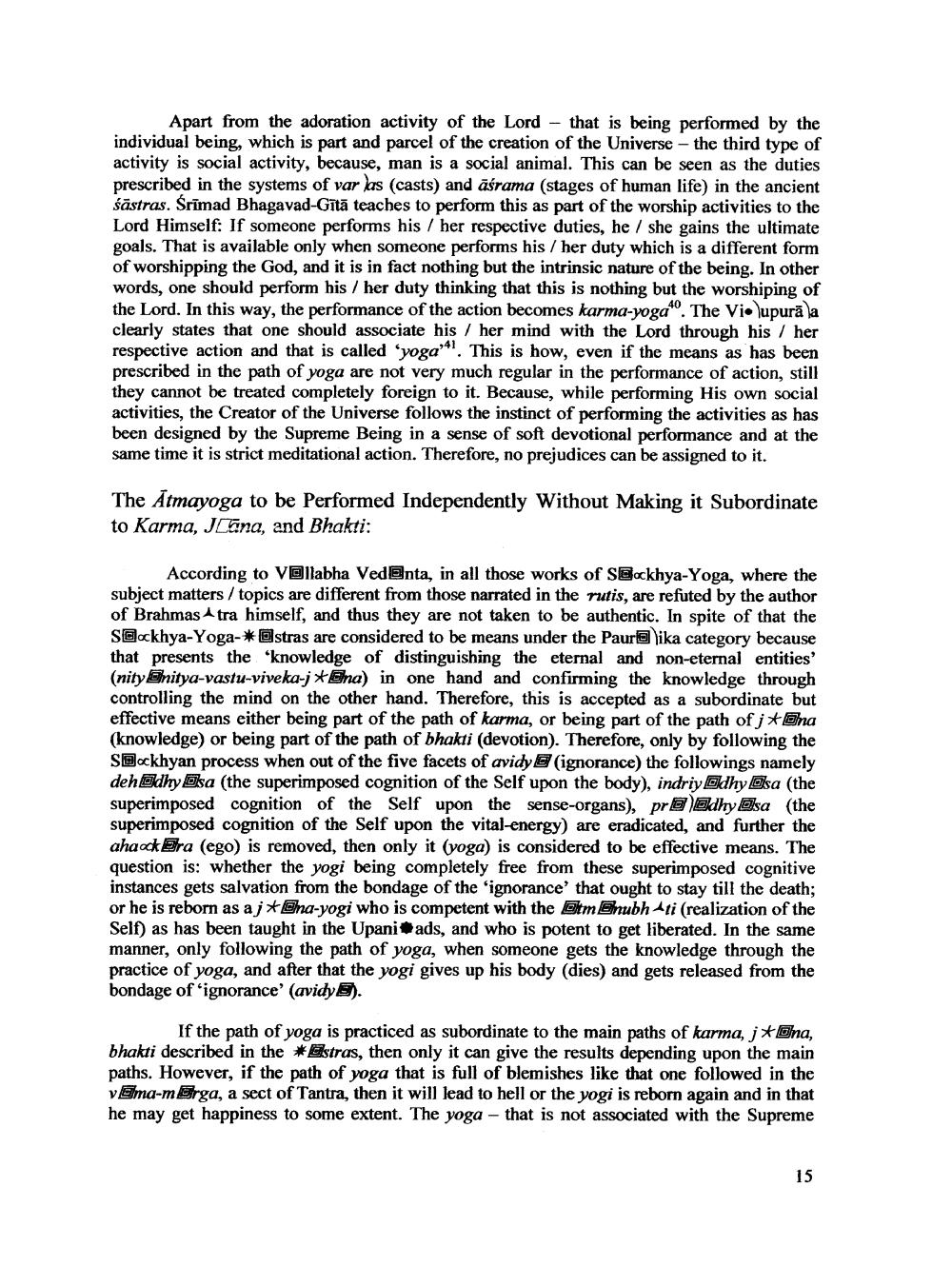________________
Apart from the adoration activity of the Lord - that is being performed by the individual being, which is part and parcel of the creation of the Universe - the third type of activity is social activity, because, man is a social animal. This can be seen as the duties prescribed in the systems of var as (casts) and aśrama (stages of human life in the ancient śāstras. Srimad Bhagavad-Gītā teaches to perform this as part of the worship activities to the Lord Himself: If someone performs his / her respective duties, he/she gains the ultimate goals. That is available only when someone performs his / her duty which is a different form of worshipping the God, and it is in fact nothing but the intrinsic nature of the being. In other words, one should perform his/her duty thinking that this is nothing but the worshiping of the Lord. In this way, the performance of the action becomes karma-yoga0. The Vi• upurā la clearly states that one should associate his / her mind with the Lord through his / her respective action and that is called "yoga-4l. This is how, even if the means as has been prescribed in the path of yoga are not very much regular in the performance of action, still they cannot be treated completely foreign to it. Because, while performing His own social activities, the Creator of the Universe follows the instinct of performing the activities as has been designed by the Supreme Being in a sense of soft devotional performance and at the same time it is strict meditational action. Therefore, no prejudices can be assigned to it.
The Atmayoga to be Performed Independently Without Making it Subordinate to Karma, Jana, and Bhakti:
According to Vallabha Vedenta, in all those works of SE.khya-Yoga, where the subject matters / topics are different from those narrated in the rutis, are refuted by the author of Brahmastra himself, and thus they are not taken to be authentic. In spite of that the S@khya-Yoga-* Ostras are considered to be means under the Paura lika category because that presents the knowledge of distinguishing the eternal and non-eternal entities' (nity Enitya-vastu-viveka-j Ena) in one hand and confirming the knowledge through controlling the mind on the other hand. Therefore, this is accepted as a subordinate but effective means either being part of the path of karma, or being part of the path of j *Ona (knowledge) or being part of the path of bhakti (devotion). Therefore, only by following the S ockhyan process when out of the five facets of avidy 3 (ignorance) the followings namely deh Odhy Osa (the superimposed cognition of the Self upon the body), indriy Odhy Osa (the superimposed cognition of the Self upon the sense-organs), pra Edhy Olsa (the superimposed cognition of the Self upon the vital-energy) are eradicated, and further the aha. Era (ego) is removed, then only it (yoga) is considered to be effective means. The question is: whether the yogi being completely free from these superimposed cognitive instances gets salvation from the bondage of the 'ignorance that ought to stay till the death; or he is reborn as a
j na-yogi who is competent with the Etm Enubh ti (realization of the Self) as has been taught in the Upani+ads, and who is potent to get liberated. In the same manner, only following the path of yoga, when someone gets the knowledge through the practice of yoga, and after that the yogi gives up his body (dies) and gets released from the bondage of 'ignorance' (avidy).
If the path of yoga is practiced as subordinate to the main paths of karma, j* Ona, bhakti described in the *Estras, then only it can give the results depending upon the main paths. However, if the path of yoga that is full of blemishes like that one followed in the vEma-mErga, a sect of Tantra, then it will lead to hell or the yogi is reborn again and in that he may get happiness to some extent. The yoga - that is not associated with the Supreme




